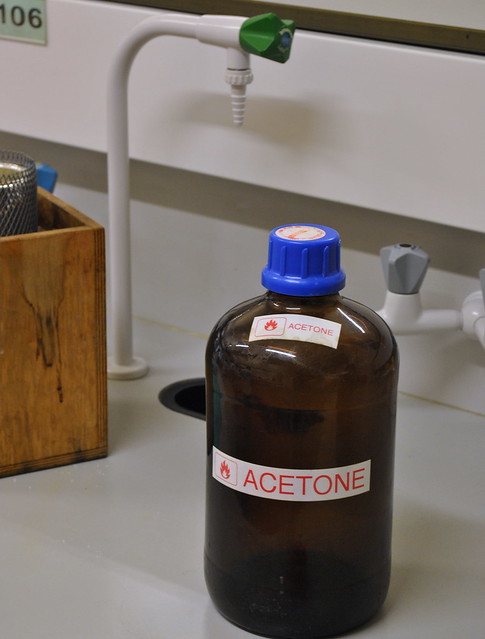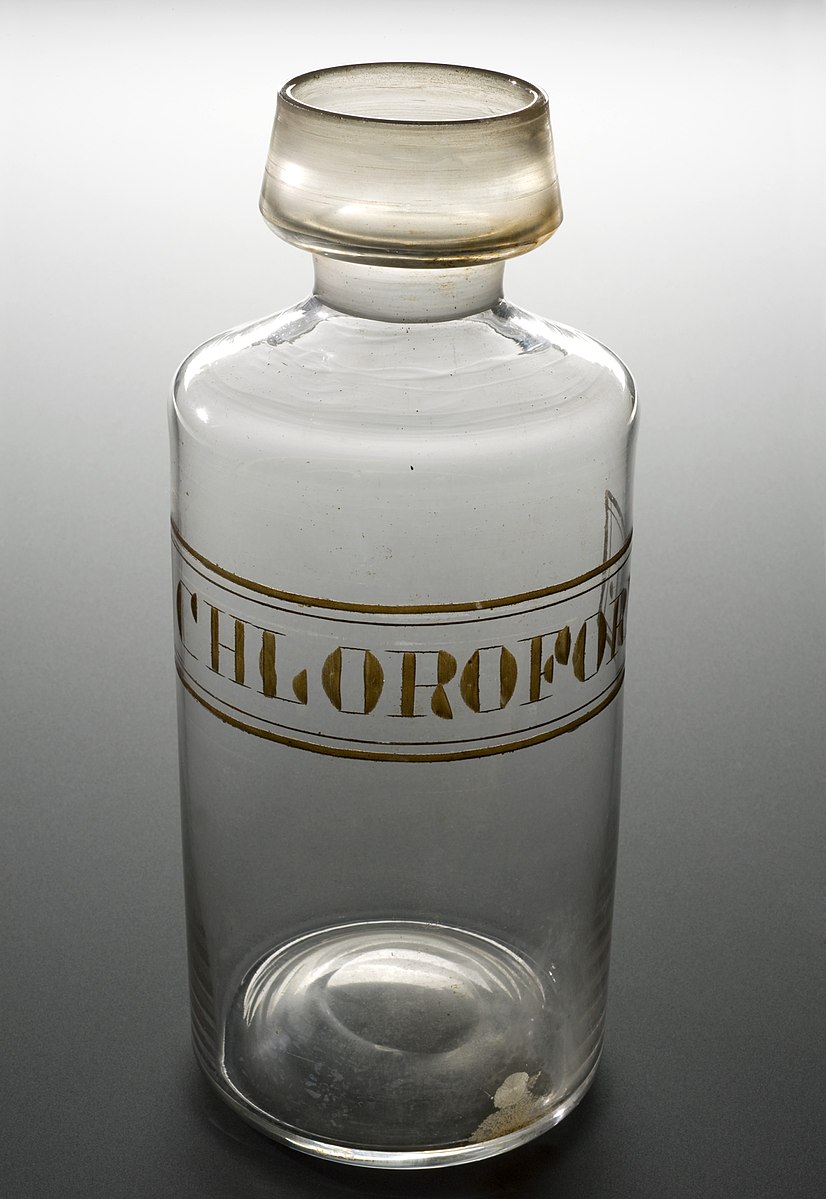Difference Between Acetone and Chloroform
Acetone and chloroform are organic compounds, volatile, colorless, colorless liquids with a typical odor. They are widely used for different purposes (mainly as solvents). Both acetone and chloroform are toxic and have to be handled with caution.

What is Acetone?
Acetone (propanone or dimethyl ketone) is an organic compound, volatile, highly flammable, colorless liquid with a typical odor. It is the simplest ketone. The chemical formula of the acetone is C3H6O.
It is believed that the Acetone was firstly synthesized during the late Middle Ages by alchemists.
Small amounts of acetone are produced in the human body. Prolonged fasting, diabetes or alcoholism can lead to a significant increase of the acetone in the blood and the so-called acetone breadth.
In industry, acetone is produced from propylene, directly or indirectly. The most common method for its production is the cumene process.
Acetone is most commonly used as a solvent, for cleaning tools, thinning polyester resin, in paints and varnishes. It is used as a degreaser in the preparation of metal prior to painting. Acetone is used in medical and cosmetic applications and in food additives. In the pharmaceutical industry, it is used as an excipient in some drugs and in the denaturant in denatured alcohol. It is often the primary component in cleaning agents and nail polish remover. Acetone is used as a solvent for the safe transportation and storage of acetylene. It is used to synthesize methyl methacrylate.
Inhalation of acetone vapor causes intoxication and dizziness. It causes dry and cracked skin. The oral LD50 for mice is 3000 mg/kg.
The molar mass of acetone is 58.08 g/mol. Its density at 25°C is 0.7845 g/cm3. Its melting point is −94.7 °C, its boiling point is 56.05 °C. The acetone is highly flammable. Its flash point is −20 °C, its autoignition temperature is 465 °C.

What is Chloroform?
Chloroform (trichloromethane), is an organic compound, colorless, dense, sweet-smelling liquid. The chemical formula of chloroform is CHCl3.
Chloroform was produced independently by different researchers in 1831.
Some seaweed species and fungi produce chloroform. Some abiotic processes in nature also contribute to natural chloroform productions in the soils.
Chloroform is produced from methane or chloromethane and chlorine at high temperatures (400–500 °C).
Chloroform is used in the production of polytetrafluoroethylene and tetrafluoroethylene (precursor to Teflon), in pesticides, as a solvent for resins, rubber, oils, fats, gutta-percha, waxes, alkaloids, etc. It is commonly used in chromatography and spectroscopy. In the past, it was widely used as an anesthetic. Before the Montreal Protocol for protection of the ozone layer, chlorodifluoromethane was a popular refrigerant.
Chloroform dissolves fats well, and dermal exposure can result in the development of sores. When ingested or inhaled, chloroform affects the central nervous system, causing coma and depression of the respiratory center. The LD50 for mice (dermal) is 704 mg/kg. The lethal oral dose for a human is estimated at about 45 g for an adult.
The molar mass of chloroform is 119.37 g/mol. Its density at 25°C is 1.489 g/cm3. The melting point of chloroform is −63.5 °C, and it decomposes at 450 °C. Its boiling point is 61.15°C.
It is non-flammable.
Difference Between Acetone and Chloroform
Definition
Acetone: Acetone (propanone or dimethyl ketone) is an organic compound, volatile, highly flammable, colorless liquid, with a typical odor.
Chloroform: Chloroform (trichloromethane), is an organic compound, colorless, dense, sweet-smelling liquid.
Chemical formula
Acetone: C3H6O.
Chloroform: CHCl3
History
Acetone: Acetone was firstly synthesized during the late Middle Ages by alchemists.
Chloroform: Chloroform was produced independently by different researchers in 1831.
Biosynthesis
Acetone: Small amounts of acetone are produced in the human body. Prolonged fasting, diabetes or alcoholism can lead to a significant increase of the acetone in the blood and the so-called acetone breadth.
Chloroform: Some seaweed species and fungi produce chloroform.
Production
Acetone: In industry, acetone is produced from propylene, directly or indirectly. The most common method for its production is the cumene process.
Chloroform: Chloroform is produced from methane or chloromethane and chlorine at high temperatures (400–500 °C).
Use
Acetone: Acetone is most commonly used as a solvent, degreaser, in medical and cosmetic applications, and in food additives. It is often the primary component in cleaning agents and nail polish remover.
Chloroform: Chloroform is used in the production of polytetrafluoroethylene and tetrafluoroethylene, in pesticides, as a solvent for resins, rubber, oils, fats, gutta-percha, waxes, alkaloids, in chromatography, spectroscopy, etc.
Toxicity
Acetone: Inhalation of acetone vapor causes intoxication and dizziness. It causes dry and cracked skin. The oral LD50 for mice is 3000 mg/kg.
Chloroform: When ingested or inhaled, chloroform affects the central nervous system, causing coma and depression of the respiratory center. Dermal exposure can result in the development of sores. The LD50 for mice (dermal) is 704 mg/kg.
Molar mass
Acetone: The molar mass of acetone is 58.08 g/mol.
Chloroform: The molar mass of chloroform is 119.37 g/mol.
Density
Acetone: The density of acetone at 25°C is 0.7845 g/cm3.
Chloroform: The density of chloroform at 25°C is 1.489 g/cm3.
Melting and boiling point
Acetone: The melting point of acetone is −94.7 °C, its boiling point is 56.05 °C.
Chloroform: The melting point of chloroform is −63.5 °C, its boiling point is 61.15°C.
Auto-ignition
Acetone: Acetone’s auto-ignition occurs at 465°C.
Chloroform: Chloroform is not combustible.
Acetone Vs. Chloroform: Comparison Table

Summary of Acetone vs. Chloroform:
- Acetone (propanone or dimethyl ketone) is an organic compound, volatile, highly flammable, colorless liquid, with a typical odor.
- Chloroform (trichloromethane), is an organic compound, colorless, dense, sweet-smelling liquid.
- The chemical formula of acetone is C3H6O, the chemical formula of chloroform is CHCl3.
- Acetone was firstly synthesized during the late Middle Ages by alchemists. Chloroform was produced independently by different researchers in 1831.
- Small amounts of acetone are produced in the human body, plants, animals. Some seaweed species and fungi produce chloroform.
- In industry, acetone is produced from propylene, directly or indirectly. Chloroform is produced from methane or chloromethane and chlorine at high temperatures.
- Acetone is most commonly used as a solvent, degreaser, in medical and cosmetic applications, in food additives. It is often the primary component in cleaning agents and nail polish remover. Chloroform is used in the production of polytetrafluoroethylene and tetrafluoroethylene, in pesticides, as a solvent for resins, rubber, oils, fats, gutta-percha, waxes, alkaloids, in chromatography, spectroscopy, etc.
- Inhalation of acetone vapor causes intoxication and dizziness. When ingested or inhaled, chloroform affects the central nervous system, causing coma and depression of the respiratory center.
- The molar mass of acetone is 58.08 g/mol. The molar mass of chloroform is 119.37 g/mol.
- The density of acetone at 25°C is 0.7845 g/cm3. The density of chloroform at 25°C is 1.489 g/cm3.
- The melting point of acetone is −94.7 °C, its boiling point is 56.05 °C. The melting point of chloroform is −63.5 °C, its boiling point is 61.15°C.
- Acetone’s auto-ignition occurs at 465°C. Chloroform is not combustible.
- Difference Between Gallstones and Cholecystitis - September 5, 2021
- Difference Between Constipation and Cramping - August 4, 2021
- Difference Between Whole Genome Sequencing and Microarray - May 6, 2021
Search DifferenceBetween.net :
Leave a Response
References :
[0]Image credit: https://www.flickr.com/photos/uclmaps/8789288850
[1]Image credit: https://commons.wikimedia.org/wiki/File:Clear_glass_shop_round_for_Chloroform,_United_Kingdom,_1850-_Wellcome_L0058939.jpg
[2]Arun, B., B.S. Bahl. A Textbook of Organic Chemistry. New Delhi: S. Chand Publishing. 2016. Print.
[3]Hoffman, R. Organic Chemistry. Hoboken: John Wiley & Sons, Inc. 2004. Print.
[4]Kirkova, E. General Chemistry. Sofia: Kliment Ohridski. 2002. Print.
